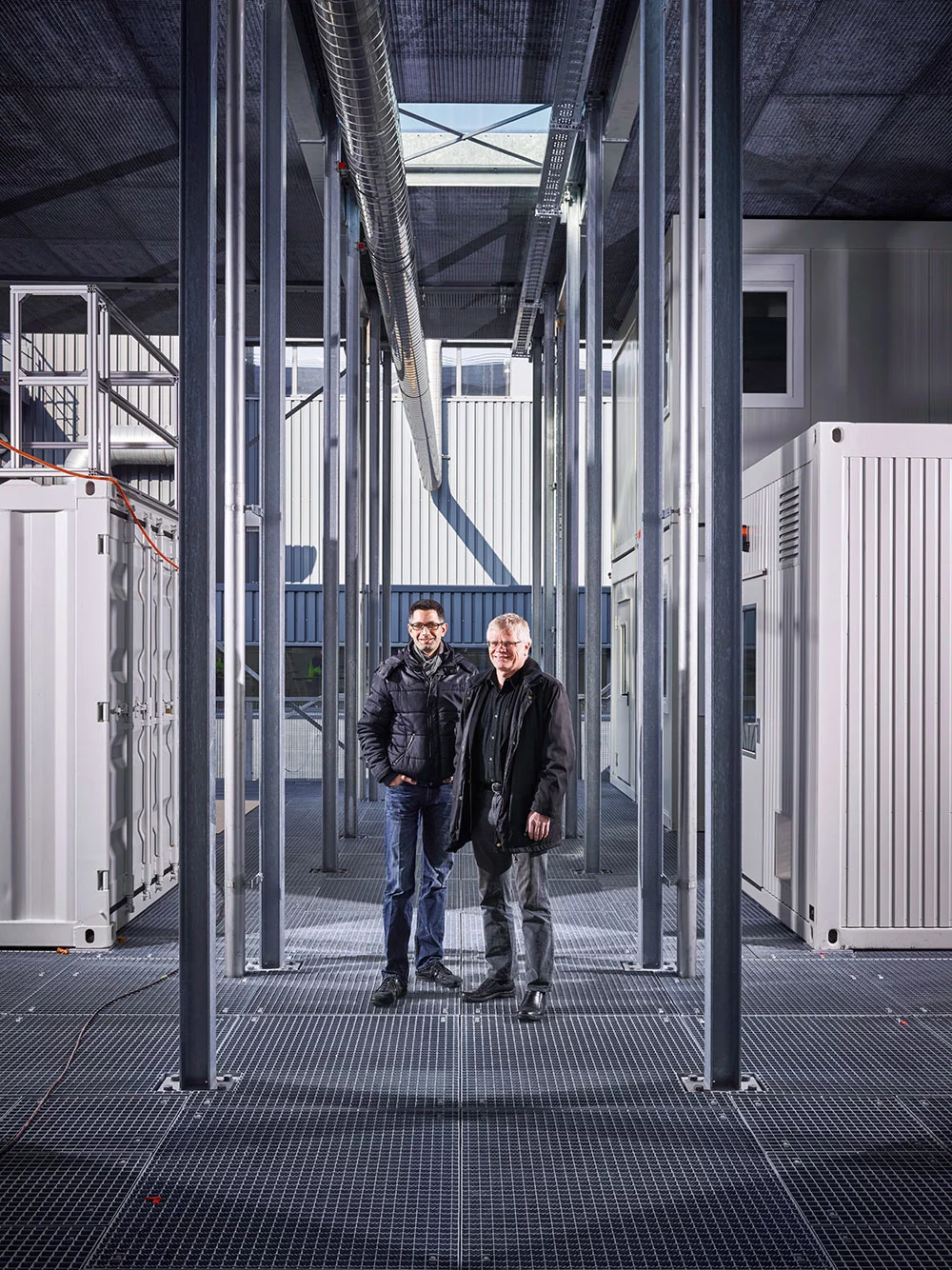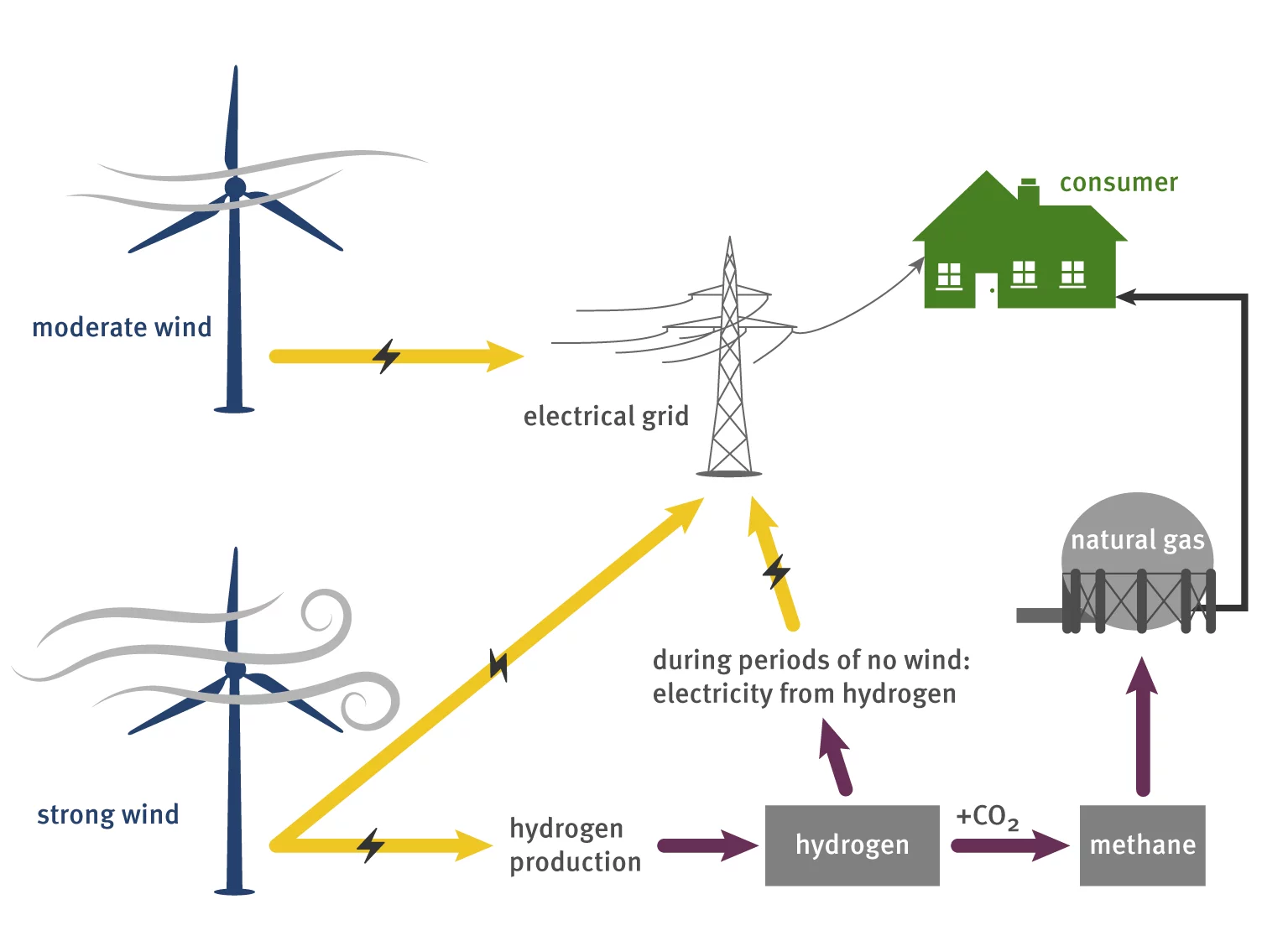As capacities for producing solar and wind energy increase, integrating these into the existing energy system is becoming more of a challenge. The ESI platform is testing methods for successful integration. The answer: storing surplus energy as gas.
One goal set out in Switzerland’s Federal Energy Strategy 2050 is the increased use of renewable energies such as solar and wind power. But when favourable weather prevails, photovoltaic installations and windmills are producing too much electricity – whilst falling short on clean energy supplies at night and during windless or foggy conditions. These fluctuations put considerable pressure on electricity grids and complicate grid operator planning. Significant costs are a further factor: producers receive compensation for every kilowatt hour that cannot be produced because grids are already functioning at maximum capacity. In 2014, German electricity producers received a total of 89 million EUR in constraint payments for electricity that could not be fed into potentially overloaded grids.
Storing Energy from Sun and Wind
"The installation of more solar and wind power plants is exacerbating the problem of integrating them into the existing energy infrastructure," says Peter Jansohn, head of the ESI (Energy System Integration) platform at the PSI. The platform brings together researchers from the PSI and from industry in several pilot plants dedicated to assessing the possible implementation of results in energy research carried out by the PSI. The plants are housed in adjacent containers located under one roof.
One important issue is the optimal use of intermittently produced solar and wind energy in Switzerland. The objective is clear enough: storing surplus energy and making it available again when needed. These are the parameters for the platform’s exploration of one of the most promising storage technologies. It’s called power-to-gas and the idea behind it is already implicit in the name: when grids are overloaded, this technology turns power into energy-rich gas. Hydrogen captured from pure water in a so-called electrolyzer is one possibility. It can be stored in tanks and used when needed by producing electricity and heat in fuel cells, for example, and making these available to power buses and cars, heat rooms and contribute towards covering the electricity needs of domestic properties.
So far, the infrastructure needed to store hydrogen has not been developed and the existing gas grid can only accept small quantities of hydrogen. A second step in the conversion process could bring better results: combining hydrogen with carbon dioxide – CO2 – will turn it into methane, the main component of natural gas. At this point, the storage capacities of the gas grid become relevant, allowing surplus energy produced during the summer months to be stored until winter. As Jansohn says: "This seasonal storage is an important advantage of the power-to-gas solution that no other storage technology is in a position to provide on this scale".
More Biogas, less CO2
This methane-production technology is part of a pilot project envisaged by the Zurich-based enterprise Energie 360° for implementation in a biogas plant. Biogas produced in sewage works or as a result of fermenting biodegradable materials already consists in large part of methane, but also contains some CO2. Separating off the CO2 previously involved a complex procedure that Energie 360° plans to bypass by converting it into more methane through the addition of hydrogen from renewable sources. "We will be able to increase production significantly," enthuses Jansohn. The conversion process will involve technology researched at the PSI and already successfully applied in Austria at a large-scale pilot facility for producing methane from waste wood – a facility for which the PSI was awarded the 2009 Watt d’Or: the Swiss Federal Office of Energy’s top award for best performers in the energy sector. The PSI technology still needs to be adapted for use in a biogas facility but scientists are confident that this will succeed.
The ESI platform is exploring the conversion of electricity into hydrogen and methane. Marcel Hofer, head of the ESI platform’s realisation team, explains the project’s purpose. "The PSI has already developed considerable competence in all individual aspects of power-to-gas technology. Now we need to gather first-hand knowledge of the complex interaction between these technologies", the main issue being to assess how flexibly, efficiently and economically a power-to-gas facility can help decongest power grids. Power-to-gas is particularly attractive when surplus electricity can be purchased cheaply and resold more expensively at a later date. "This is likely to happen regularly in the future," says Jansohn, "during phases when a lot of renewable energy is in the grid." Electricity to gas conversion must also be efficient: once the storage process has been completed, 70 percent of the previously existing energy should remain available in the hydrogen. 60 percent is considered a realistic benchmark when converting to methane. "Ideally, such a facility should also come with a long service life and low maintenance costs," says Jansohn.
Load Balancing
The national grid operator Swissgrid is interested in one more potential use of this technology. A joint research project undertaken with the PSI is exploring how quickly power-to-gas facilities will achieve load balancing when pressure on electricity supplies threaten to destabilize the grid – either as a result of peak demand or peak production. "We’d also like to know whether a prescient distribution of power-to-gas facilities in Switzerland will obviate the need for investments required to significantly enlarge renewable energy resources," adds Jansohn. The ESI platform helps project partners come considerably closer to finding answers to questions such as these.
Further Information
Overview: ESI Platform – new pathways to the energy system of the futurePartners of the ESI Platform
Contact
Martina Gröschl, Communications DepartmentPaul Scherrer Institute, 5232 Villigen PSI
Telefon: +41 56 310 52 13, E-Mail: martina.groeschl@psi.ch


